Fire Resistance of Reinforced Concrete T-Beams with Circular Web Openings
Abstract
1. Introduction
2. Experimental Program
2.1. Material Properties
2.2. Description of Specimens
2.3. Location and Size of Circular Openings
2.4. Test Setup and Procedure
2.5. Temperature and Displacement Measurement
3. Test Results and Discussion
3.1. Experimental Observations and Failure Modes
3.2. Temperature of the Furnace and Measuring Points
- (1)
- The temperature change was first fast and then slow; the average temperature of the furnace was in good agreement with the ISO-834 standard fire curve, indicating that the horizontal furnace of the fire-resistance laboratory of Huaqiao University met the requirements in national standard [61]. In general, the furnace heating curves measured in the fire tests can simulate real fire conditions.
- (2)
- The average furnace temperatures at the beginning of T1, T2, T3, and T4 were 38 °C, 37 °C, 42 °C, and 32 °C, respectively. Furthermore, the furnace was turned off at 127 min, 126 min, 122 min, and 103 min for T1, T2, T3, and T4, reaching maximum furnace temperatures of 1060 °C, 1057 °C, 1056 °C, and 1032 °C, respectively.
- (3)
- The temperatures of T2-2, T3-2, and T4-2 match well with the measured furnace temperature.
- (1)
- Because point 6 of T1; point 4, point 6, point 10, and point 12 of T2 and T3; point 6, point 10, and point 12 of T4 measured the temperatures of longitudinal reinforcements, they reached the highest temperature almost immediately after flameout and then cooled down at a fast rate. The temperatures of points on sections with openings were higher than those on sections without openings. The temperatures of T2-4, T2-6, T3-4, T3-6, and T3-6 were 18 °C, 5 °C, 8 °C, 6 °C, and 105 °C higher than those of T2-10, T2-12, T3-10, T3-12, and T3-12, respectively.
- (2)
- The temperatures of points such as T2-1, T3-1, and T4-3 close to the fire exposed sides dropped quickly after the flameout, while the temperatures of some points such as point 7, point 8, and point 9 in sections without openings of T2~T4, far away from the fire exposed sides, showed the thermal inertia of concrete apparently and did not fall immediately.
- (3)
- There were “temperature plateaus” [65] with different lengths around 100 °C in the temperature rise curves of the measuring points, which was due to the fact that the heat was continuously carried away by the water evaporation inside the concrete. The closer the measuring point was to the fire exposed side, the faster the concrete heated up and the moisture inside the concrete evaporated. As a result, the length of the temperature plateau was a significant positive correlation with the distance between the measuring point and the fire exposed side.
3.3. Fire Resistance and Deformation of Specimens
- (1)
- The mid-span deflections of the specimens increased with time in general. The actuator was stopped at the same time as the flame was turned off, and then the mid-span deflections of T1~T3 rebounded by 13.7 mm, 20.1 mm, and 23.4 mm, subsequently. However, the mid-span deflection of T4 could not be rebounded due to the rupture of three longitudinal reinforcements. The bending stiffness of T1~T4 decreased sequentially. The mid-span deflections of T1~T4 at the flameout moment were 285.2 mm, 285.6 mm, 285.0 mm, and 285.6 mm, respectively. The mid-span deflections of T1~T4 at the end of fire tests were 224.7 mm, 222.4 mm, 219.4 mm, and 287.8 mm, respectively. Except that no recovery happened to T4, the recovery ratios of T1~T3 were 21.2%, 22.1%, and 23.0%, respectively. The deformation recovery ability still performed well for the RC T-beam with a circular opening under the premise that the depth of the bottom chord was 220 mm.
- (2)
- The fire resistances of T1~T4 were 127 min, 126 min, 122 min, and 103 min, respectively. Compared with T1, the fire resistances of T2 and T4 were reduced by 0.8% and 18.9%, respectively. The fire resistance was reduced with the depth of the bottom chord. When the depth was 100 mm, the failure mode of the RC T-beam with a circular opening under fire changed from ductile failure to brittle failure.
- (3)
- Compared with T1, the fire resistance of T3 was reduced by 3.9%. The fire resistance was influenced by the cutting off of stirrups on the premise that the depth of the bottom chord was 220 mm, but no brittle failure occurred.
- (4)
- After the actuator load was applied, the mid-span deflections of T1~T4 were 11.8 mm, 15.2 mm, 19.4 mm, and 15.2 mm, respectively. Compared with T1, the mid-span deflections of T2~T4 after the loading increased by 28.8%, 64.4%, and 28.8%, respectively, which showed that both drilling an opening and cutting off the stirrups could increase the mid-span deflection of the RC T-beam.
- (1)
- For T1, the mid-span deflection increased rapidly after the temperature of longitudinal reinforcement at the beam bottom beyond 600 °C until the fire resistance.
- (2)
- For T2~T4, the mid-span deflection increased rapidly after the temperatures of T2-4, T2-10, T3-4, T3-10, and T4-10 reached 500 °C and the temperatures of T2-6, T2-12, T3-6, T3-12, T4-6, and T4-12 reached 600 °C until the fire-resistance, which could be since points 4 and 10 were close to the beam bottom while points 6 and 12 were close to the beam bottom and the web side.
4. Numerical Simulation
4.1. Finite Element Modeling
4.2. Validation of Numerical Modeling and Analysis
4.3. Numerical Results and Discussion
5. Simplified Calculation of the Flexural Capacity of the RC T-Beam with a Circular Opening under Fire
6. Conclusions
- (1)
- In the case of a 100 mm bottom chord and an uncut stirrup, the fire resistance of the RC T-beam with a circular opening was 18.9% lower than the normal RC T-beam, and brittle failure occurred. The fire resistance of the RC T-beams with an uncut stirrup and a cutting stirrup were 0.8% and 4.0% lower than the normal RC T-beam, respectively, both failing in ductile mode. Consequently, an opening at the appropriate location would ensure that the fire resistance of the RC T-beam remained almost constant.
- (2)
- The FE model can simultaneously simulate the temperature field of the RC T-beams with a circular opening at high temperature and the mechanical response of the beams under concentrated load, which can provide a helpful reference for applying static load levels on the RC T-beams with a circular opening under fire.
- (3)
- FE models indicated that brittle failure of the specimen under fire can be avoided with a reasonable depth of the bottom chord. For the case of the specimens in this study, the depth of the bottom chord should be ensured to be no less than 120 mm. The parametric analysis illustrated that the fire resistance decreased with the increasing design load ratio.
- (4)
- Within the parameter range of this study, the 300–800 °C isotherm method was demonstrated to be a good method for calculating the flexural capacity of the RC T-beam with a circular opening under fire. By evaluating the relationship between the flexural capacity and the internal force of the section of the RC T-beam after the creating of the opening, the suitability of the opening location can be assessed.
Author Contributions
Funding
Data Availability Statement
Acknowledgments
Conflicts of Interest
References
- Mansur, M.A.; Tan, K.H.; Lee, S.L. Collapse loads of R/C beams with large openings. J. Struct. Eng. 1984, 110, 2602–2618. [Google Scholar] [CrossRef]
- Mansur, M.A.; Lee, Y.F.; Tan, K.H.; Lee, S.L. Tests on RC continuous beams with openings. J. Struct. Eng. 1991, 117, 1593–1606. [Google Scholar] [CrossRef]
- Mansur, M.A.; Tan, K.H.; Lee, Y.F.; Lee, S.L. Piecewise linear behavior of RC beams with openings. J. Struct. Eng. 1991, 117, 1607–1621. [Google Scholar] [CrossRef]
- Mansur, M.A.; Huang, L.M.; Tan, K.H.; Lee, S.L. Deflections of reinforced concrete beams with web openings. ACI Struct. J. 1992, 89, 391–397. [Google Scholar] [CrossRef]
- Mansur, M.A.; Tan, K.H.; Weng, W. Analysis of reinforced concrete beams with circular openings using strut-and-tie model. Struct. Eng. Mech. Comput. 2001, 1, 311–318. [Google Scholar] [CrossRef]
- Tan, K.H.; Mansur, M.A. Design procedure for reinforced concrete beams with large web openings. ACI Struct. J. 1996, 93, 404–411. [Google Scholar] [CrossRef]
- Aykac, B.; Kalkan, I.; Aykac, S.; Egriboz, Y.E. Flexural behavior of RC beams with regular square or circular web openings. Eng. Struct. 2013, 56, 2165–2174. [Google Scholar] [CrossRef]
- Barney, G.B.; Corley, W.G.; Hanson, J.M.; Parmelee, R.A. Behavior and design of prestressed concrete beams with large web openings. PCI J. 1977, 22, 32–61. [Google Scholar] [CrossRef]
- Kennedy, J.B.; Abdalla, H. Static response of prestressed girders with openings. J. Struct. Eng. 1992, 118, 488–504. [Google Scholar] [CrossRef]
- Mansur, M.A. Effect of openings on the behaviour and strength of R/C beams in shear. Cem. Concr. Comp. 1998, 20, 477–486. [Google Scholar] [CrossRef]
- Mansur, M.A. Design of reinforced concrete beams with small openings under combined loading. ACI Struct. J. 1999, 96, 675–682. [Google Scholar] [CrossRef]
- Tan, K.H.; Mansur, M.A.; Wei, W. Design of reinforced concrete beams with circular openings. ACI Struct. J. 2001, 98, 407–415. [Google Scholar] [CrossRef]
- Yang, K.H.; Eun, H.C.; Chung, H.S. The influence of web openings on the structural behavior of reinforced high-strength concrete deep beams. Eng. Struct. 2006, 28, 1825–1834. [Google Scholar] [CrossRef]
- Hassan, N.Z.; Sherif, A.G.; Zamarawy, A.H. Finite element analysis of reinforced concrete beams with opening strengthened using FRP. Ain Shams Eng. J. 2017, 8, 531–537. [Google Scholar] [CrossRef]
- Osman, B.H.; Wu, E.; Ji, B. Abdulhameed SS. Shear behavior of Reinforced Concrete (RC) beams with circular web openings without additional shear reinforcement. KSCE J. Civ. Eng. 2017, 21, 296–306. [Google Scholar] [CrossRef]
- Sayed, A.M. Numerical study using FE simulation on rectangular RC beams with vertical circular web openings in the shear zones. Eng. Struct. 2019, 198, 109471. [Google Scholar] [CrossRef]
- Jabbar, D.N.; Al-Rifaie, A.; Hussein, A.M.; Shubbar, A.A.; Nasr, M.S.; Al-Khafajief, Z.S. Shear behaviour of reinforced concrete beams with small web openings. Mater. Today Proc. 2021, 42, 2713–2716. [Google Scholar] [CrossRef]
- Nie, X.F.; Zhang, S.S.; Teng, J.G.; Chen, G.M. Experimental study on RC T-section beams with an FRP-strengthened web opening. Compos. Struct. 2018, 185, 273–285. [Google Scholar] [CrossRef]
- Nie, X.F.; Zhang, S.S.; Chen, G.M.; Yu, T. Strengthening of RC beams with rectangular web openings using externally bonded FRP: Numerical simulation. Compos. Struct. 2020, 248, 112552. [Google Scholar] [CrossRef]
- Nie, X.F.; Zhang, S.S.; Yu, T. Behaviour of RC beams with a fibre-reinforced polymer (FRP)-strengthened web opening. Compos. Struct. 2020, 252, 112684. [Google Scholar] [CrossRef]
- Teng, J.G.; Nie, X.F.; Zhang, S.S. Strengths of RC beams with a fibre-reinforced polymer (FRP)-strengthened web opening. Compos. Struct. 2021, 258, 113380. [Google Scholar] [CrossRef]
- Teng, J.G.; Nie, X.F.; Zhang, S.S. On the FE modelling of RC beams with a fibre-reinforced polymer (FRP)-strengthened web opening. Compos. Struct. 2021, 258, 114161. [Google Scholar] [CrossRef]
- Wu, B.; Tang, G.H. State-of-the-art of fire-resistance study on concrete structures in recent years. J. Build. Struct. 2010, 31, 110–121. (In Chinese) [Google Scholar] [CrossRef]
- Xu, Y.Y.; Wu, B.; Wang, R.H.; Jiang, M.; Luo, Y. Experimental study on residual performance of reinforced concrete beams after fire. J. Build. Struct. 2013, 34, 20–29. (In Chinese) [Google Scholar] [CrossRef]
- Xiong, Y.; Chen, A.; Wu, D.; Zhao, G. Seismic Performance of Composite Shear Walls Filled with Demolished Concrete Lumps and Self-Compacting Concrete after Fire. Buildings 2022, 12, 1308. [Google Scholar] [CrossRef]
- Yang, Z.; Wang, L. Fractal Analysis of Tunnel Structural Damage Caused by High-Temperature and Explosion Impact. Buildings 2022, 12, 1410. [Google Scholar] [CrossRef]
- Abid, S.R.; Abbass, A.A.; Murali, G.; Al-Sarray, M.L.J.; Nader, I.A.; Ali, S.H. Post-High-Temperature Exposure Repeated Impact Response of Steel-Fiber-Reinforced Concrete. Buildings 2022, 12, 1364. [Google Scholar] [CrossRef]
- Lie, T.T. Fire resistance of circular steel columns filled with bar-reinforced concrete. J. Struct. Eng. 1994, 120, 1489–1509. [Google Scholar] [CrossRef]
- Kodur, V.K.R.; Sultan, M.A. Effect of temperature on thermal properties of high-strength concrete. J. Mater. Civ. Eng. 2003, 15, 101–107. [Google Scholar] [CrossRef]
- Bažant, Z.P.; Wang, T.S. Practical prediction of cyclic humidity effect in creep and shrinkage of concrete. Mater. Struct. 1985, 18, 247–252. [Google Scholar] [CrossRef]
- Khoury, G.A.; Dias, W.P.; Sullivan, P.J.E. Deformation of concrete and cement paste loaded at constant temperatures from 140 to 724 °C. Mater. Struct. 1986, 19, 97–104. [Google Scholar] [CrossRef]
- Schneider, U. Concrete at high temperatures—A general review. Fire Saf. J. 1988, 13, 55–68. [Google Scholar] [CrossRef]
- Castillo, C.; Durranil, A.J. Effect of transient high temperature on high-strength concrete. ACI Mater. J. 1990, 87, 47–53. [Google Scholar] [CrossRef]
- Thienel, K.C.; Rostasy, F.S. Strength of concrete subjected to high temperature and biaxial stress: Experiments and modeling. Mater. Struct. 1995, 28, 575–581. [Google Scholar] [CrossRef]
- Hu, H.T.; Dong, Y.L. Experimental research on the transient thermal strain of high strength concrete at elevated temperature. J. Build. Struct. 2002, 23, 32–47. (In Chinese) [Google Scholar] [CrossRef]
- Hu, H.T.; Dong, Y.L. Experimental research on strength and deformation of high-strength concrete at elevated temperature. China Civ. Eng. J. 2002, 35, 44–47. (In Chinese) [Google Scholar] [CrossRef]
- Gawin, D.; Pesavento, F.; Schrefler, B.A. Modelling of hygro-thermal behaviour of concrete at high temperature with thermo-chemical and mechanical material degradation. Comput. Method. Appl. M. 2003, 192, 1731–1771. [Google Scholar] [CrossRef]
- Arioz, O. Effects of elevated temperatures on properties of concrete. Fire Saf. J. 2007, 42, 516–522. [Google Scholar] [CrossRef]
- Xing, W.L.; Shi, X.D.; Ni, J.G. Short-term thermal creep model of concrete based on experiments. Eng. Mech. 2011, 28, 158–163. Available online: https://www.engineeringmechanics.cn/article/id/1578 (accessed on 16 January 2023). (In Chinese).
- Lie, T.T. A procedure to calculate fire resistance of structural members. Fire Mater. 1984, 8, 40–48. [Google Scholar] [CrossRef]
- Dorn, J.E. Some fundamental experiments on high temperature creep. J. Mech. Phys. Solids. 1955, 3, 85–116. [Google Scholar] [CrossRef]
- Harmathy, T.Z. A comprehensive creep model. J. Basic Eng. 1967, 89, 496–502. [Google Scholar] [CrossRef]
- Kodur, V.K.R.; Dwaikat, M. A numerical model for predicting the fire resistance of reinforced concrete beams. Cem. Concr. Comp. 2008, 30, 431–443. [Google Scholar] [CrossRef]
- Hou, X.M.; Zheng, W.Z. Introduction of the main contents of structural fire design in eurocode of design of concrete structures (I)—Effects of actions and design resistance in the fire situation, material properties and fire design method based on tabulated data. Ind. Constr. 2008, 38, 98–103. (In Chinese) [Google Scholar] [CrossRef]
- Felicetti, R.; Gambarova, P.G.; Meda, A. Residual behavior of steel rebars and R/C sections after a fire. Constr. Build. Mater. 2009, 23, 3546–3555. [Google Scholar] [CrossRef]
- Elghazouli, A.Y.; Cashell, K.A.; Izzuddin, B.A. Experimental evaluation of the mechanical properties of steel reinforcement at elevated temperature. Fire Saf. J. 2009, 44, 909–919. [Google Scholar] [CrossRef]
- Wu, B.; Liang, Y.H. Statistic analysis of strengths of concrete and steel bars at elevated temperature. J. Nat. Disasters. 2010, 19, 136–142. (In Chinese) [Google Scholar] [CrossRef]
- Kodur, V.K.R.; Dwaikat, M. Effect of high temperature creep on the fire response of restrained steel beams. Mater. Struct. 2010, 43, 1327–1341. [Google Scholar] [CrossRef]
- El-Hawary, M.M.; Ragab, A.M.; El-Azim, A.A.; Elibiari, S. Effect of fire on shear behaviour of R.C. beams. Comput. Struct. 1997, 65, 281–287. [Google Scholar] [CrossRef]
- Choi, E.G.; Shin, Y.S.; Kim, H.S. Structural damage evaluation of reinforced concrete beams exposed to high temperatures. J. Fire Prot. Eng. 2013, 23, 135–151. [Google Scholar] [CrossRef]
- Ozbolt, J.; Bosnjak, J.; Periskic, G.; Sharma, A. 3D numerical analysis of reinforced concrete beams exposed to elevated temperature. Eng. Struct. 2014, 58, 166–174. [Google Scholar] [CrossRef]
- Youssef, M.A.; El-Fitiany, S.F.; Diab, M.A. Shear capacity of RC beams at elevated temperatures. Mag. Concr. Res. 2015, 67, 1190–1203. [Google Scholar] [CrossRef]
- Cai, J.; Burgess, I.; Plank, R. A generalised steel/reinforced concrete beam-column element model for fire conditions. Eng. Struct. 2003, 25, 817–833. [Google Scholar] [CrossRef]
- Bratina, S.; Saje, M.; Planinc, I. The effects of different strain contributions on the response of RC beams in fire. Eng. Struct. 2007, 29, 418–430. [Google Scholar] [CrossRef]
- ISO 834-1; International Standard, Fire-Resistance Tests—Elements of Building Construction—Part 1: General Requirements. International Organization for Standardization: Geneva, Switzerland, 1999.
- GB/T 50081-2019; Standard for Test Methods of Concrete Physical and Mechanical Properties. Ministry of Housing and Urban-Rural Development of the People’s Republic of China: Beijing, China, 2019. (In Chinese)
- Xiao, J.Z.; König, G. Study on concrete at high temperature in China—An overview. Fire Saf. J. 2004, 39, 89–103. [Google Scholar] [CrossRef]
- Kodur, V. Properties of concrete at elevated temperatures. ISRN Civ. Eng. 2014, 2014, 468510. [Google Scholar] [CrossRef]
- GB/T 228.1-2021; Metallic materials—Tensile testing—Part 1: Method of Test at Room Temperature. State Administration for Market Regulation: Beijing, China, 2021. (In Chinese)
- GB 50010-2010; Code for the Design of Concrete Structures. Ministry of Housing and Urban-Rural Development of the People’s Republic of China: Beijing, China, 2010. (In Chinese)
- GB/T 9978.1-2008; Fire-resistance tests—Elements of building construction—Part 1: General requirements. State Administration for Market Regulation: Beijing, China, 2008. (In Chinese)
- Zhu, H.; Wu, G.; Zhang, L.; Zhang, J.F.; Hui, D. Experimental study on the fire resistance of RC beams strengthened with near-surface-mounted high-Tg BFRP bars. Compos. Part B-Eng. 2014, 60, 680–687. [Google Scholar] [CrossRef]
- Gao, W.Y.; Dai, J.G.; Teng, J.G. Fire resistance design of un-protected FRP-strengthened RC beams. Mater. Struct. 2016, 49, 5357–5371. [Google Scholar] [CrossRef]
- Gao, W.Y.; Dai, J.G.; Teng, J.G. Fire resistance of RC beams under design fire exposure. Mag. Concr. Res. 2017, 69, 402–423. [Google Scholar] [CrossRef]
- Wang, Y.; Duan, Y.K.; Zhang, Y.J.; Zhang, G.Y.; Qiu, C.H.; Yuan, G.L. Experimental study and theoretical analysis of concrete continuous slabs with different spans subject to fire in order. China Civ. Eng. J. 2019, 52, 23–40. (In Chinese) [Google Scholar] [CrossRef]
- EN 1992-1-2:2004:E; Eurocode 2—Design of concrete structures—Part 1-2: General Rules—Structural Fire Design. European Committee for Standardization: Bruxelles, Belgium, 2004.
- Lubliner, J.; Oliver, J.; Oller, S.; Oñate, E. A plastic-damage model for concrete. Int. J. Solids Struct. 1989, 25, 299–326. [Google Scholar] [CrossRef]
- Zhang, B.; Bicanic, N.; Pearce, C.J.; Balabanic, G. Residual fracture properties of normal- and high-strength concrete subject to elevated temperatures. Mag. Concr. Res. 2000, 52, 123–136. [Google Scholar] [CrossRef]
- Cooke, G.M.E. An introduction to the mechanical properties of structural steel at elevated temperatures. Fire Saf. J. 1988, 13, 45–54. [Google Scholar] [CrossRef]
- DBJ/T 15-81-2011; Code for fire resistance design of concrete building structures. Department of Housing and Urban-Rural Development of Guangdong Province: Guangzhou, China, 2011. (In Chinese)
- Institution of Structural Engineers. Design and Detailing of Concrete Structures for Fire Resistance; Institution of Structural Engineers: London, UK, 1978. [Google Scholar]
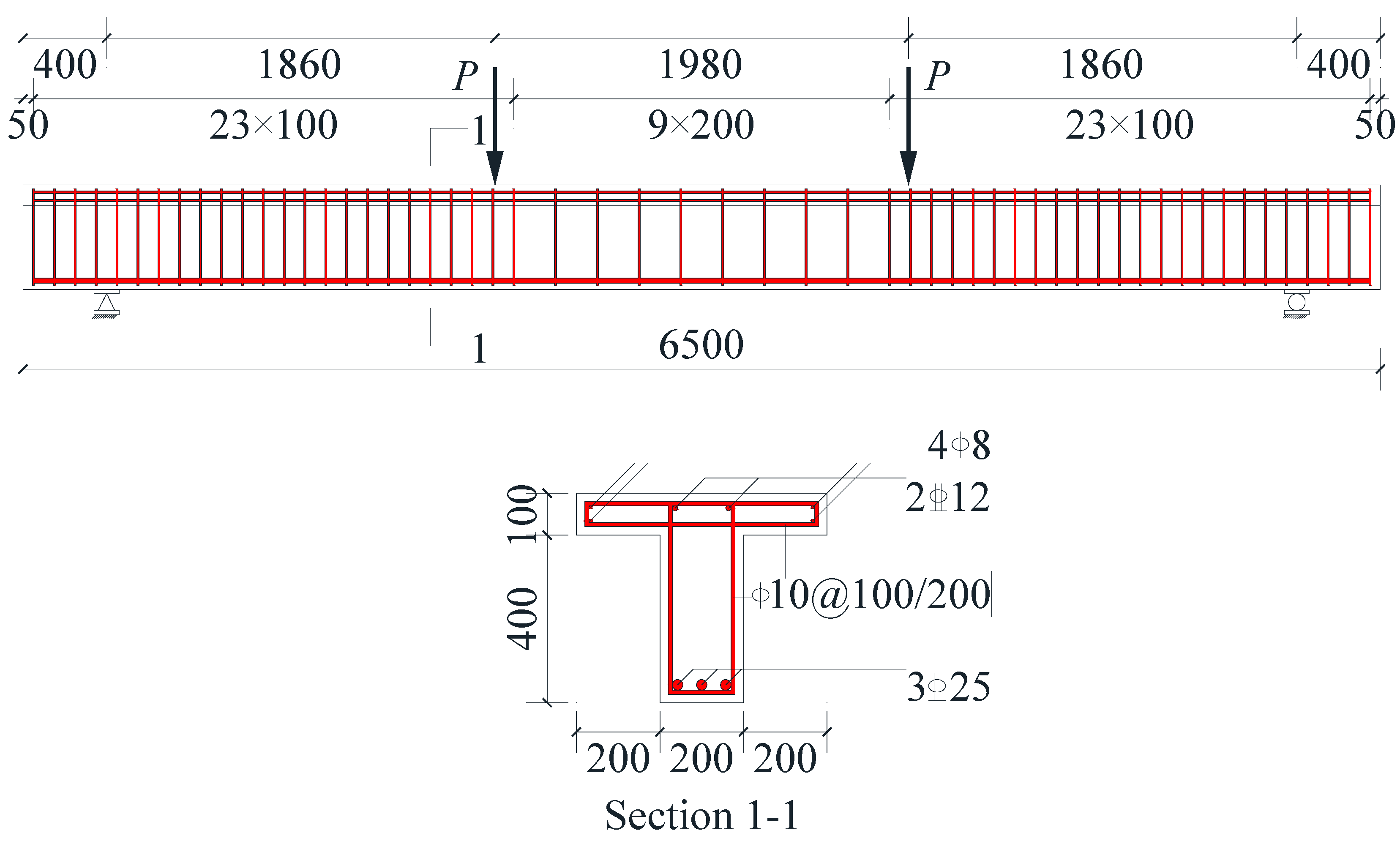

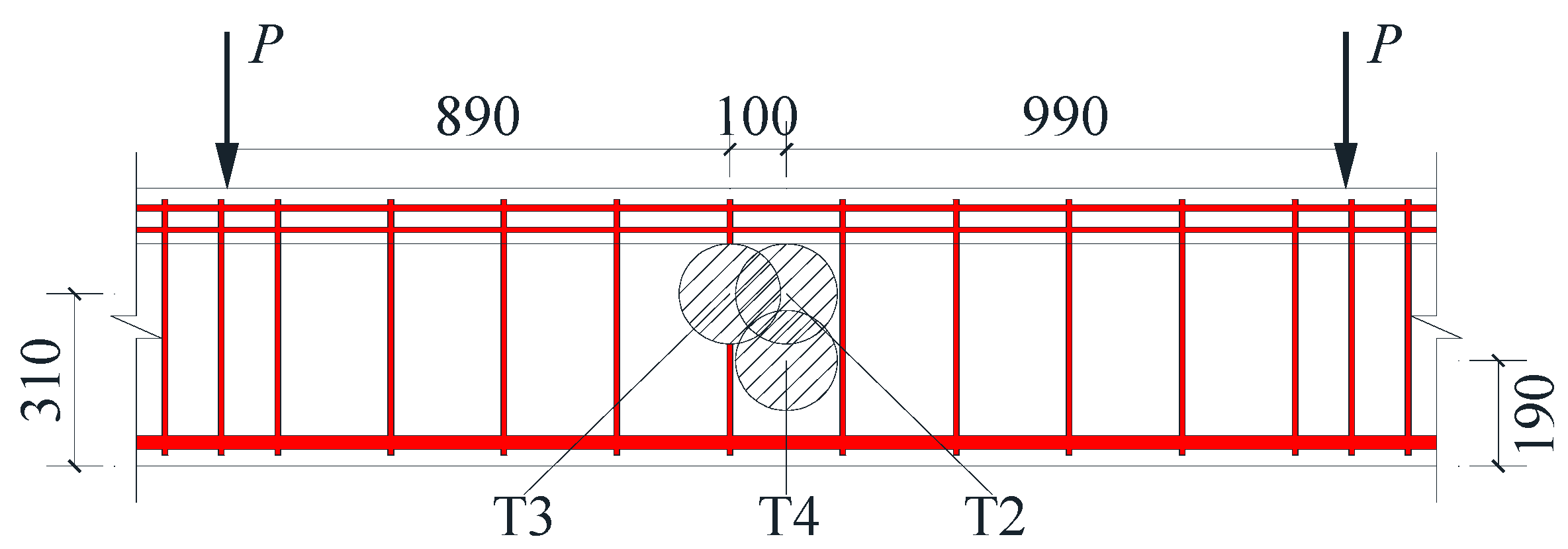

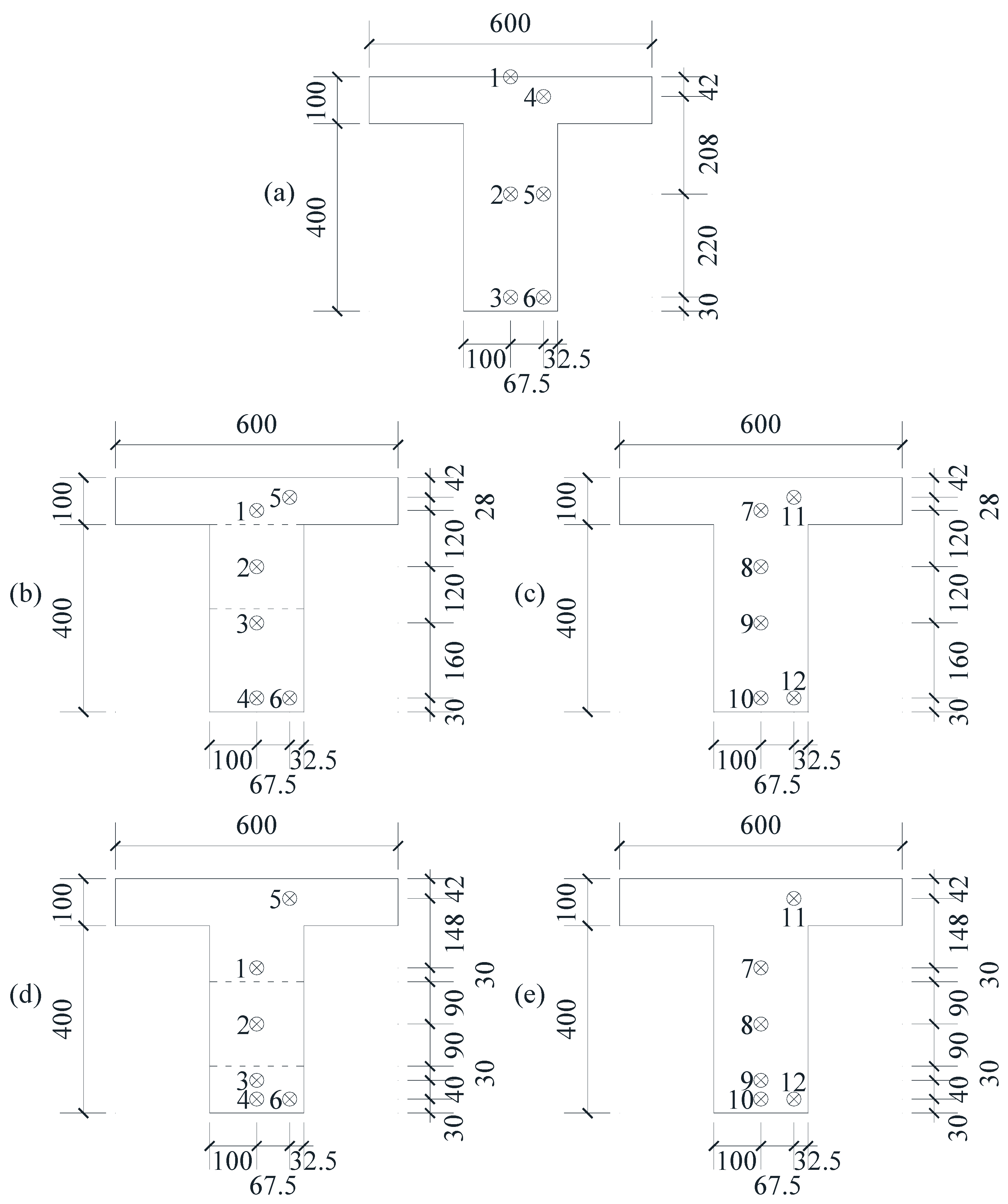
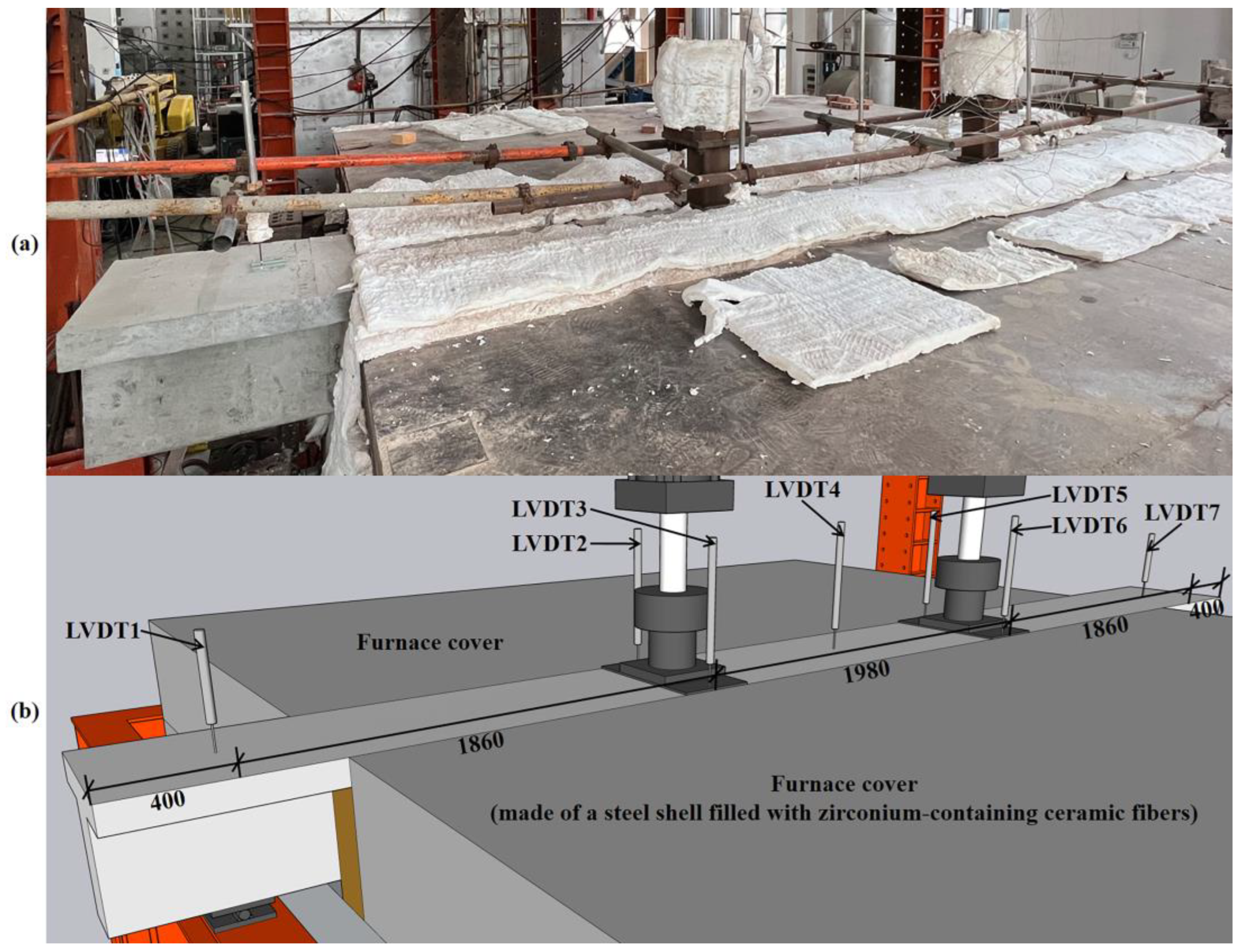
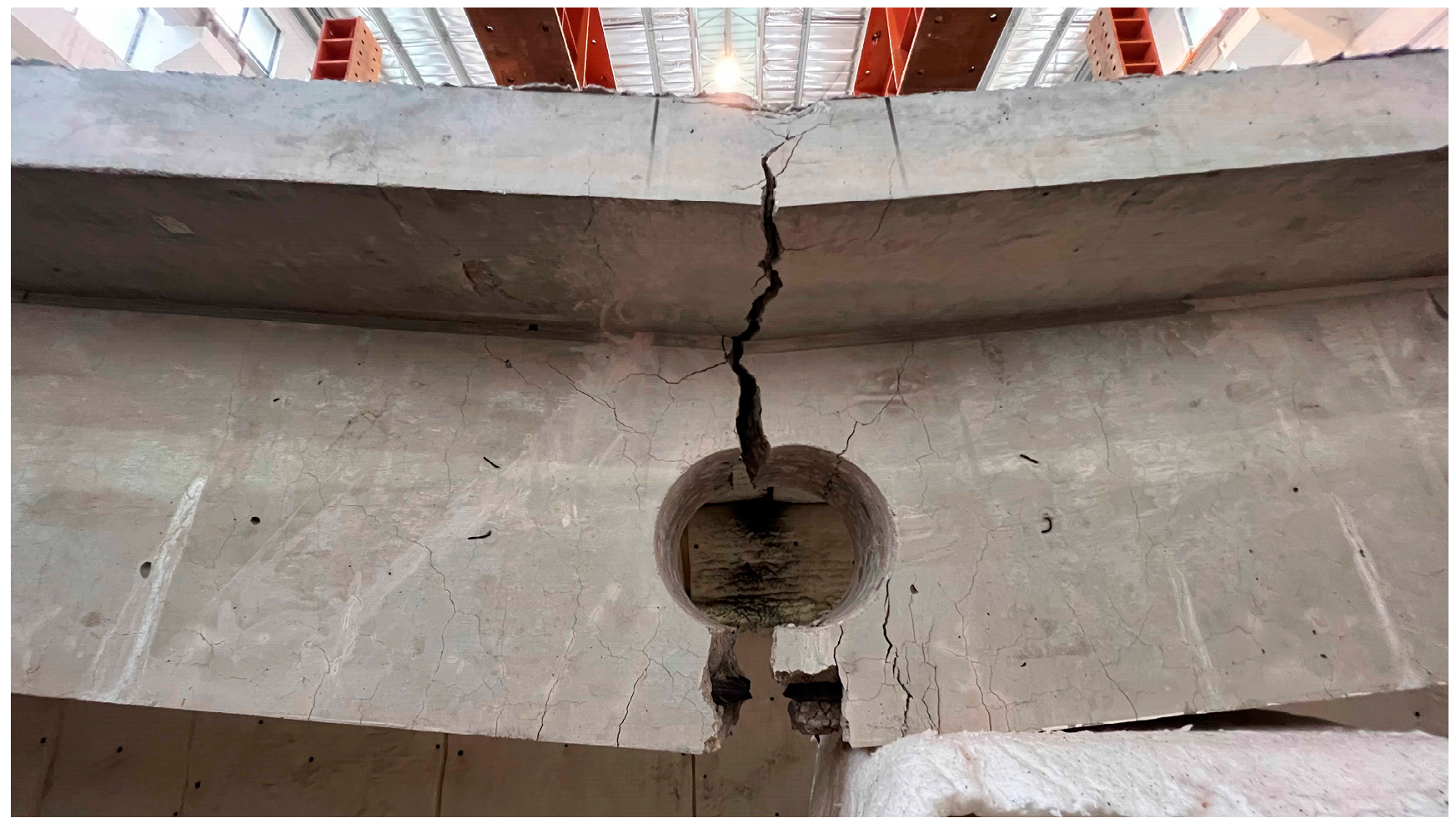
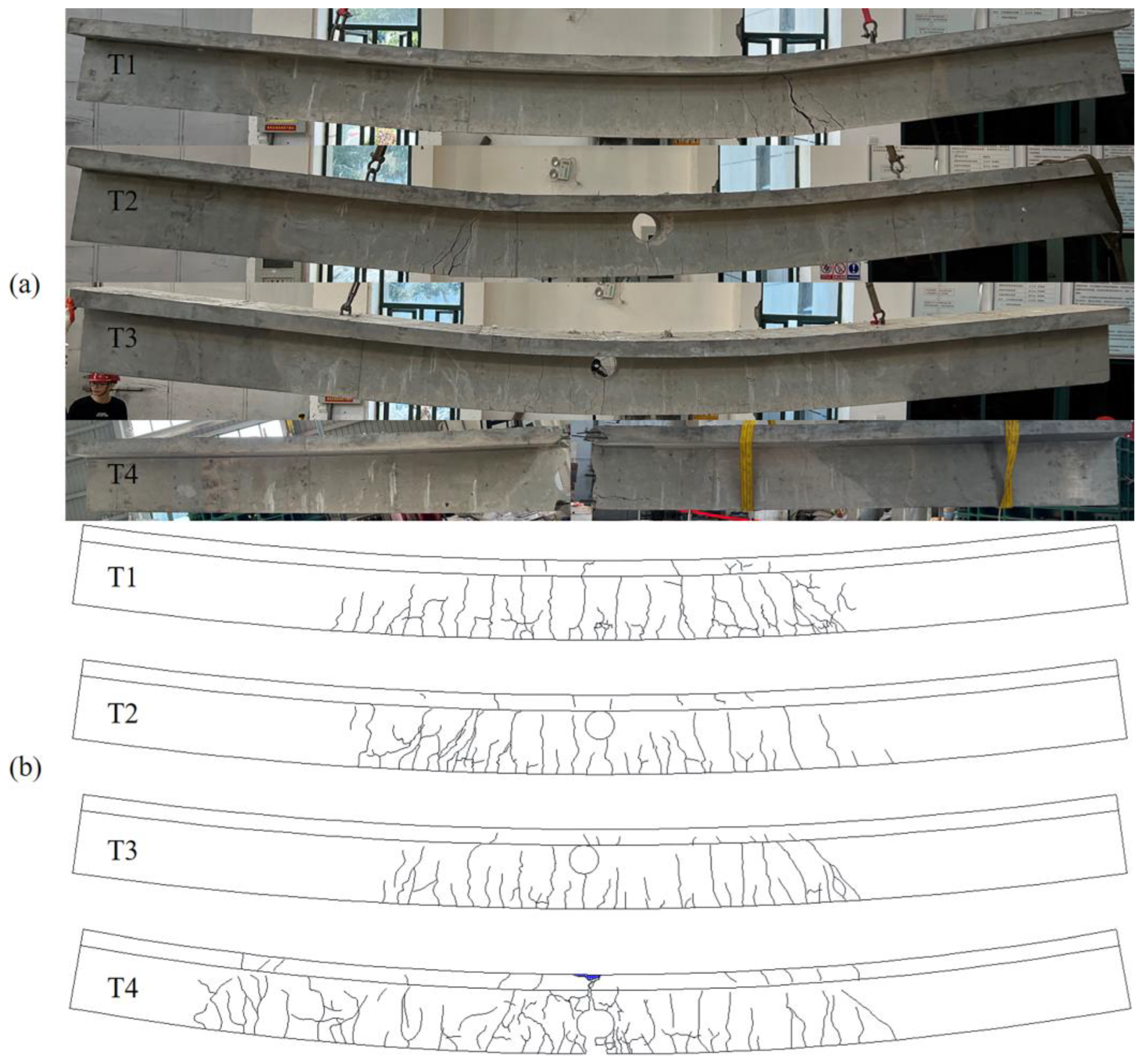



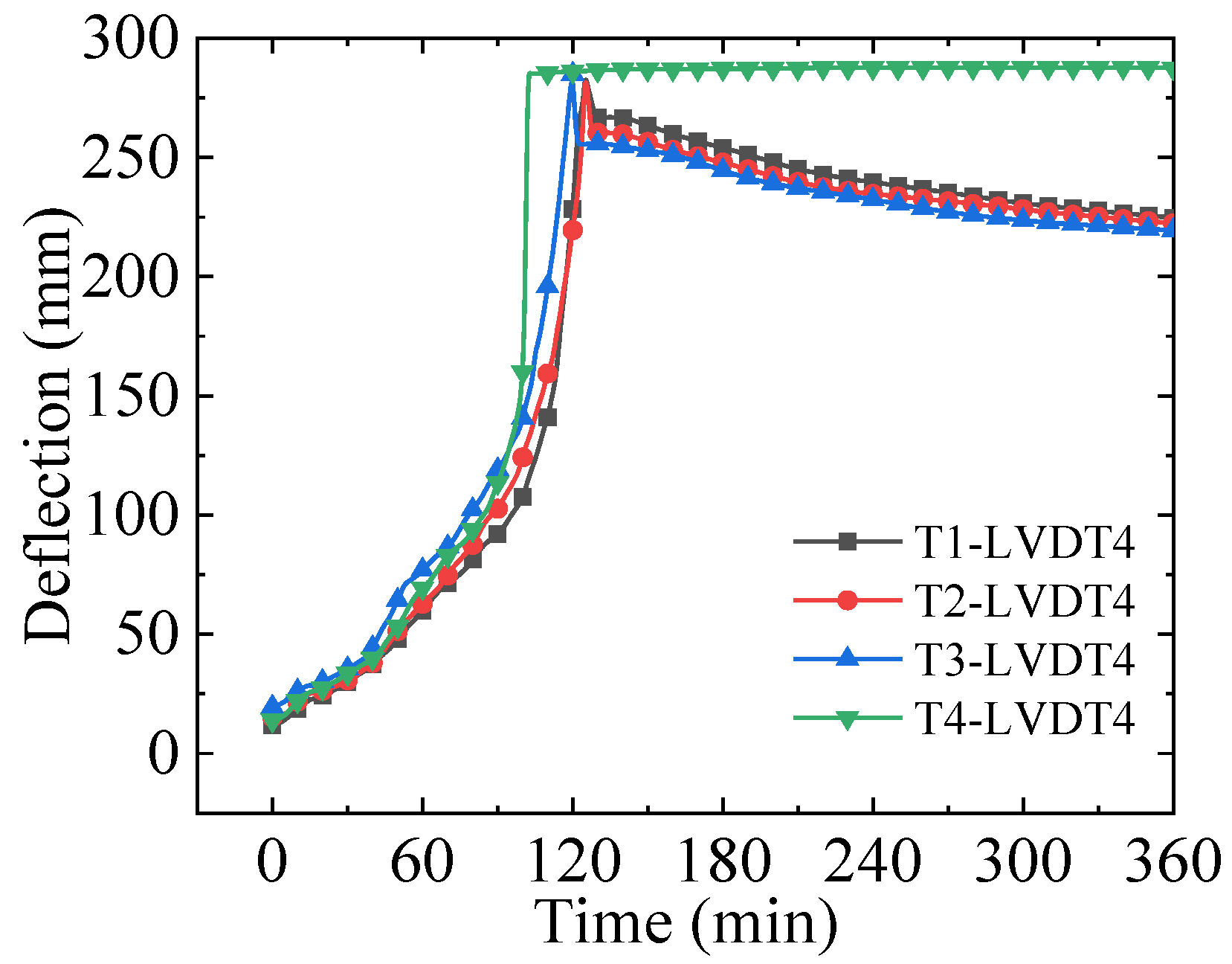
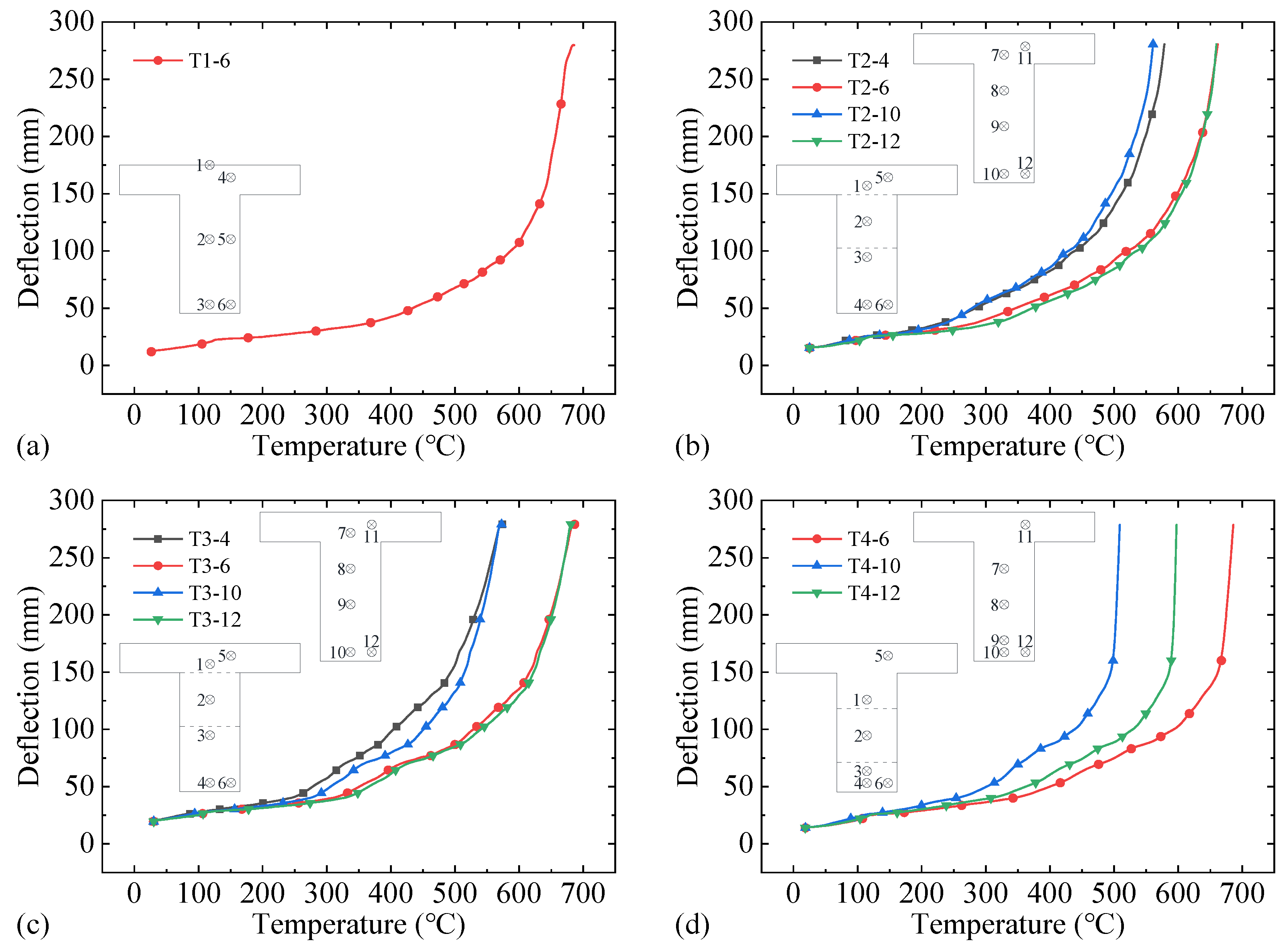

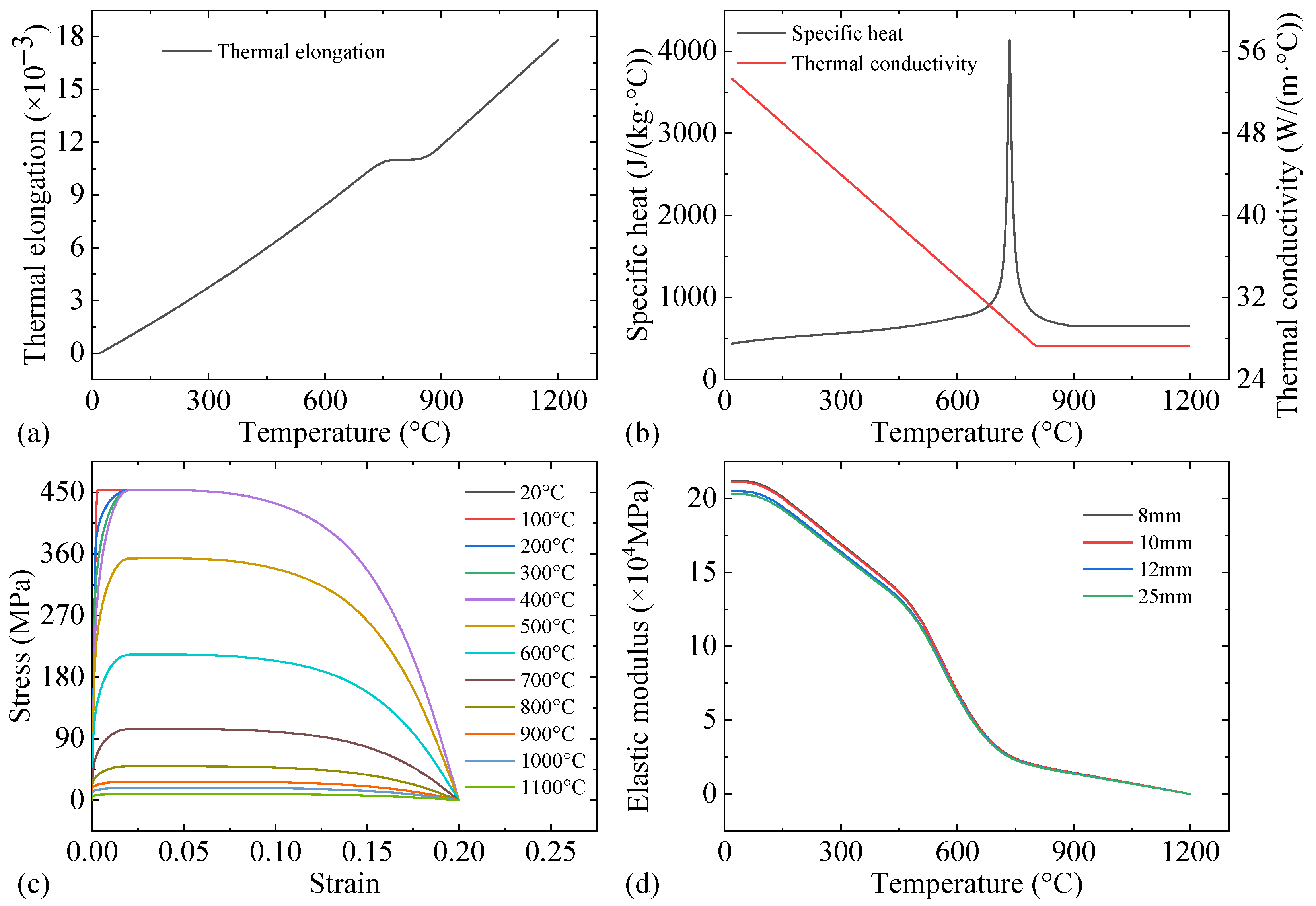

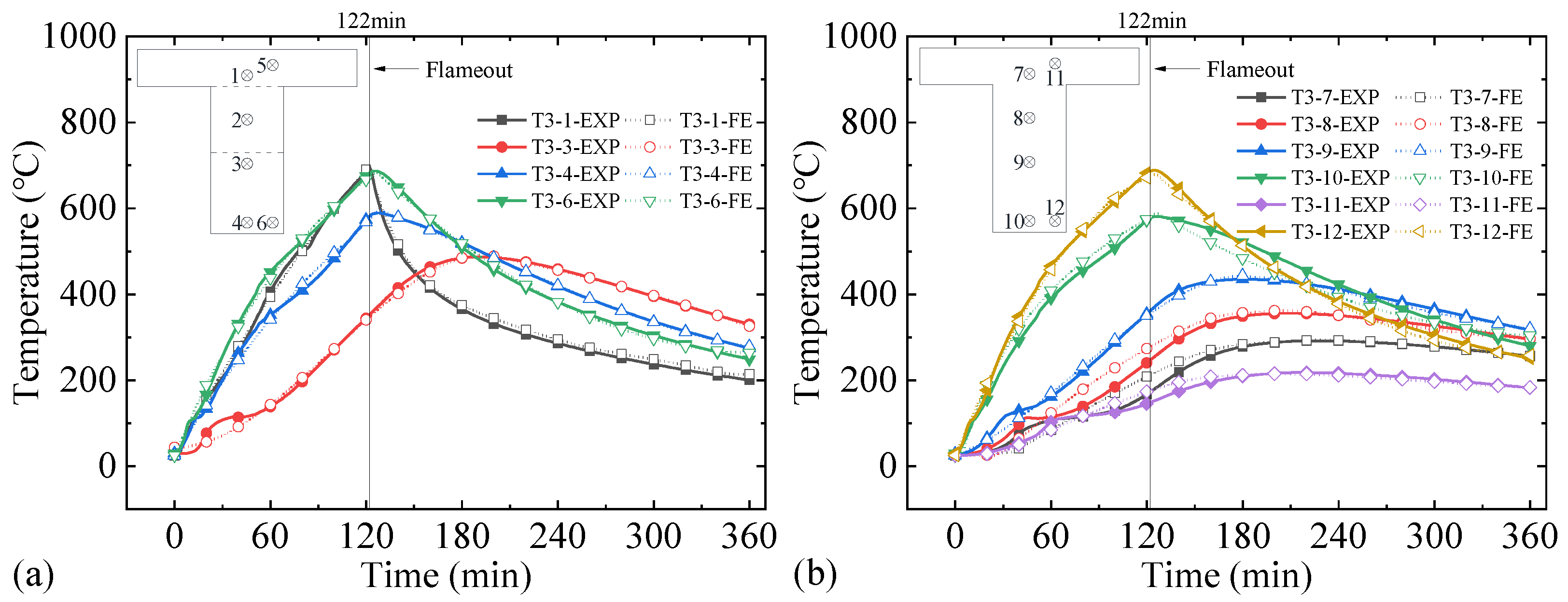
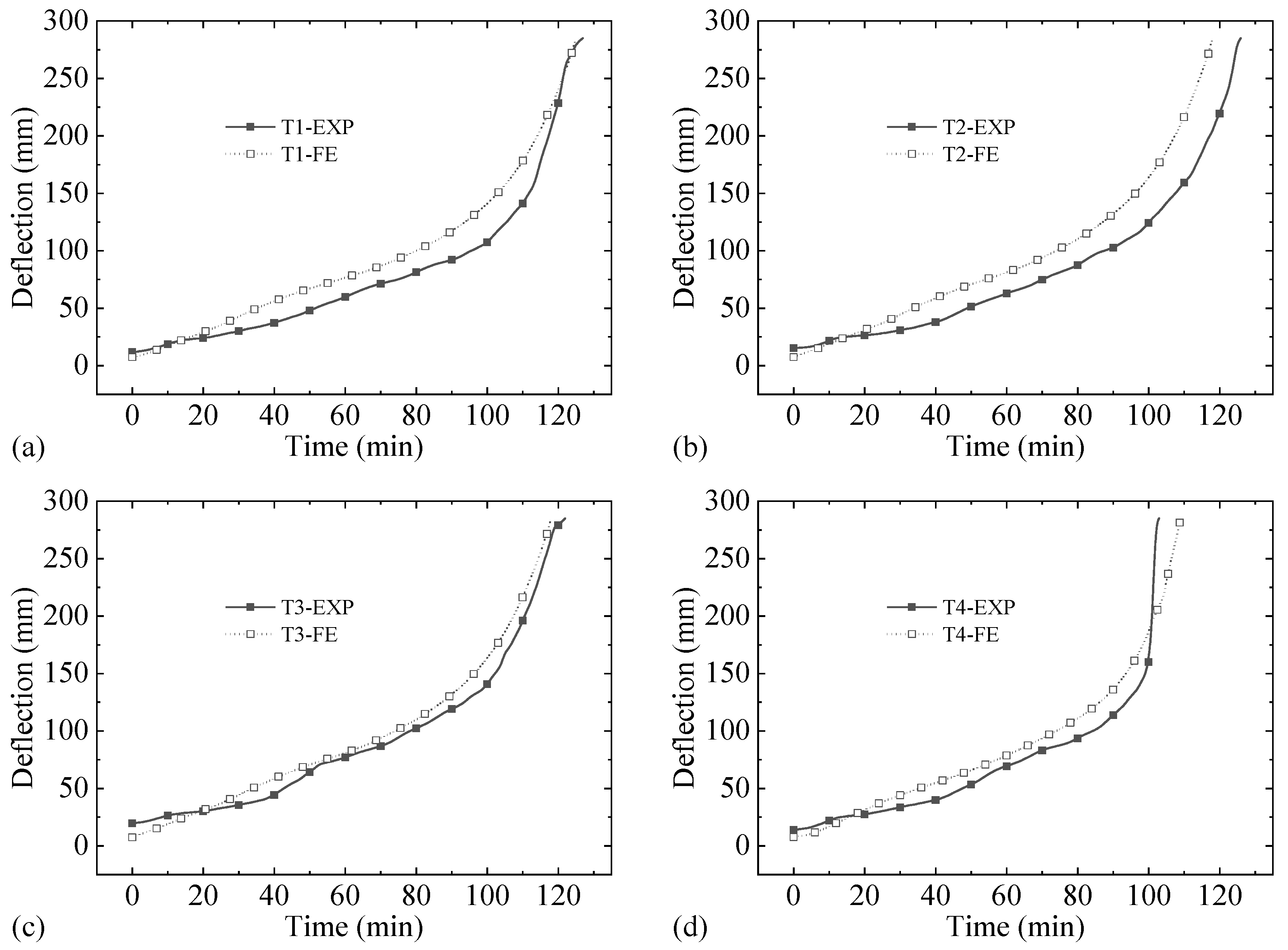



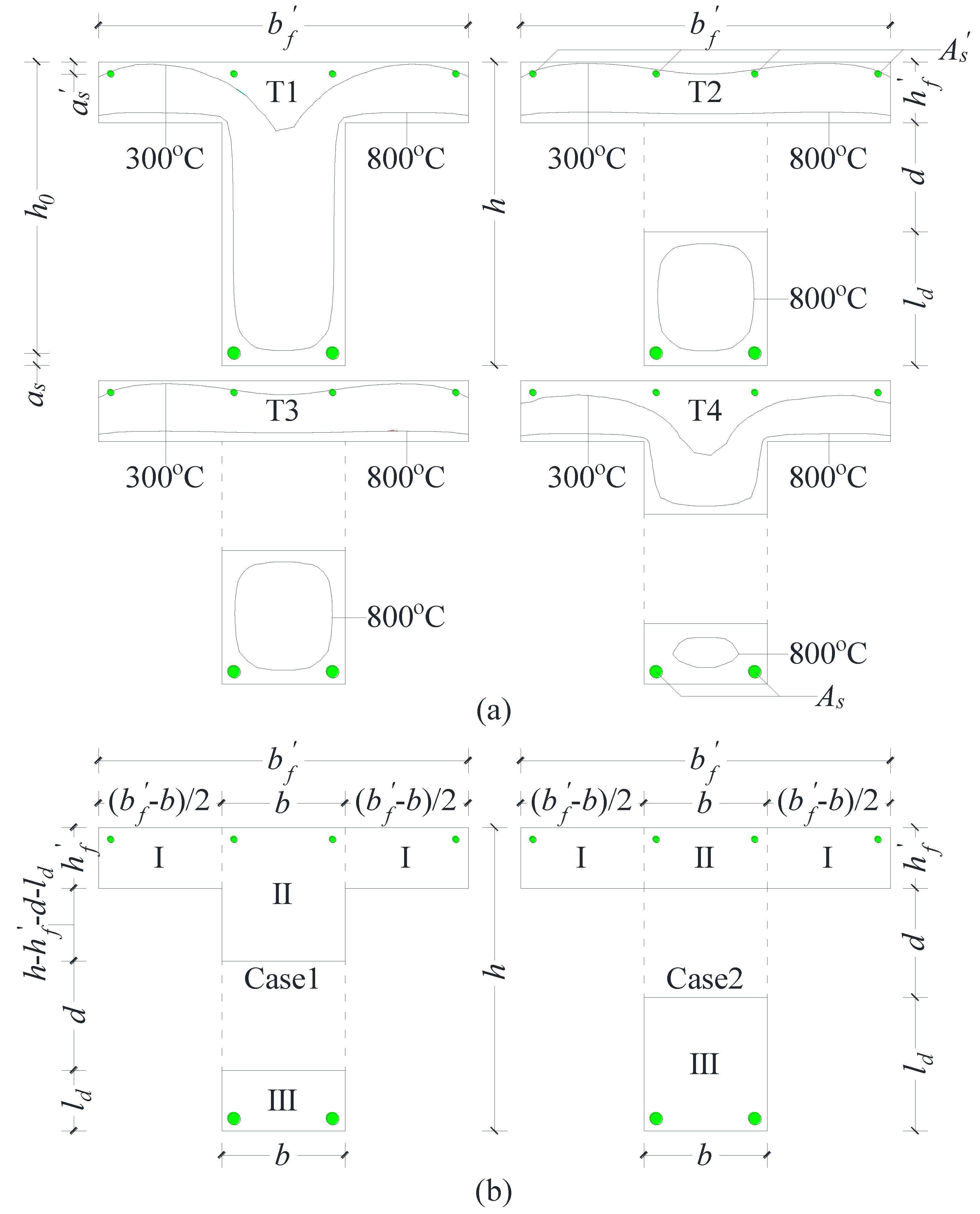


| Material | Consumption (kg/m3) | Mix Proportion |
|---|---|---|
| Ordinary Portland cement (42.5R) | 305 | 1 |
| Water | 163 | 0.534 |
| Sand | 721 | 2.364 |
| Gravel (5 mm~20 mm) | 336 | 1.102 |
| Gravel (16 mm~31.5 mm) | 760 | 2.492 |
| Water reducer | 6.7 | 0.022 |
| Fly ash 1 | 29 | 0.095 |
| Mineral powder 2 | 29 | 0.095 |
| Measuring Time | Compressive Strength, fcu (MPa) | Moisture Content, ω (%) |
|---|---|---|
| 28 days | 57.9 | 2.35 |
| Fire tests (330 days) | 64.2 | 2.32 |
| Reinforcement Type | ds1 (mm) | fy2 (MPa) | ɛy3 (10−3) | fu4 (MPa) | E5 (N/mm2) |
|---|---|---|---|---|---|
| HPB300 | 8 | 479 | 2.281 | 667 | 2.12 × 105 |
| HPB300 | 10 | 503 | 2.395 | 666 | 2.11 × 105 |
| HRB400 | 12 | 488 | 2.440 | 675 | 2.05 × 105 |
| HRB400 | 25 | 453 | 2.265 | 660 | 2.03 × 105 |
| Specimens | lc 1 (mm) | ld 2 (mm) | Cut Off the Stirrup | tm 3 (min) |
|---|---|---|---|---|
| T1 | – | – | – | 127 |
| T2 | 310 | 220 | No | 126 |
| T3 | 310 | 220 | Yes | 122 |
| T4 | 190 | 100 | No | 103 |
| Specimen | Measuring Point | Temperature (°C) | Measuring Point | Temperature (°C) |
|---|---|---|---|---|
| T1 | T1-4 | - | - | - |
| T1-6 | 697 | - | - | |
| T2 | T2-4 | 592 | T2-10 | 574 |
| T2-6 | 670 | T2-12 | 665 | |
| T3 | T3-4 | 589 | T3-10 | 581 |
| T3-6 | 687 | T3-12 | 681 | |
| T4 | T4-4 | - | T4-10 | 527 |
| T4-6 | 717 | T4-12 | 612 |
| Specimen | ld (mm) | Specimen | ld (mm) | Specimen | ld (mm) |
|---|---|---|---|---|---|
| T4 | 100 | T8 | 140 | T12 | 180 |
| T5 | 110 | T9 | 150 | T13 | 190 |
| T6 | 120 | T10 | 160 | T14 | 200 |
| T7 | 130 | T11 | 170 | T15 | 210 |
| T2 | 220 |
| Specimen | ld (mm) | tme (min) | Specimen | ld (mm) | tme (min) | Specimen | ld (mm) | tme (min) |
|---|---|---|---|---|---|---|---|---|
| T4 | 100 | 109 | T8 | 140 | 118 | T12 | 180 | 122 |
| T5 | 110 | 110 | T9 | 150 | 120 | T13 | 190 | 122 |
| T6 | 120 | 115 | T10 | 160 | 120 | T14 | 200 | 120 |
| T7 | 130 | 117 | T11 | 170 | 121 | T15 | 210 | 119 |
| T2 | 220 | 118 |
| Specimen | ld (mm) | tme (min) | |||
|---|---|---|---|---|---|
| rd 1 = 0.3 | rd = 0.5 | rd = 0.6 | rd = 0.7 | ||
| T1 | - | 178 | 138 | 125 | 117 |
| T2 | 220 | 166 | 129 | 118 | 108 |
| T3 | 220 | 166 | 129 | 118 | 108 |
| T4 | 100 | 147 | 117 | 109 | 98 |
| Specimen | Location of the Longitudinal Reinforcement | Tl 1 (°C) | Location of the Longitudinal Reinforcement | Ts 2 (°C) |
|---|---|---|---|---|
| T1 | Middle | 650 | Middle | 580 |
| Corner | 665 | Corner | 712 | |
| T2 | Middle | 644 | Middle | 586 |
| Corner | 659 | Corner | 693 | |
| T3 | Middle | 621 | Middle | 575 |
| Corner | 635 | Corner | 673 | |
| T4 | Middle | 615 | Middle | 596 |
| Corner | 629 | Corner | 672 |
| Specimens | ld (mm) | tm (min) | Mul 1 (kN·m) | Mut 2 (kN·m) | Mul/Mut | Error | Mus 3 (kN·m) | Mus/Mut | Error |
|---|---|---|---|---|---|---|---|---|---|
| T1 | - | 127 | 151.4 | 168.7 | 0.90 | −0.10 | 140.2 | 0.83 | −0.17 |
| T2 | 220 | 126 | 155.6 | 167.6 | 0.93 | −0.07 | 149.7 | 0.89 | −0.11 |
| T3 | 220 | 122 | 171.3 | 168.1 | 1.02 | 0.02 | 161.9 | 0.96 | −0.04 |
| T4 | 100 | 103 | 175.0 | 166.5 | 1.05 | 0.05 | 158.9 | 0.95 | −0.05 |
| Average | 0.97 | −0.03 | 0.87 | −0.09 |
Disclaimer/Publisher’s Note: The statements, opinions and data contained in all publications are solely those of the individual author(s) and contributor(s) and not of MDPI and/or the editor(s). MDPI and/or the editor(s) disclaim responsibility for any injury to people or property resulting from any ideas, methods, instructions or products referred to in the content. |
© 2023 by the authors. Licensee MDPI, Basel, Switzerland. This article is an open access article distributed under the terms and conditions of the Creative Commons Attribution (CC BY) license (https://creativecommons.org/licenses/by/4.0/).
Share and Cite
Jin, X.; Xu, Y.; Zhu, W.; Zhang, D. Fire Resistance of Reinforced Concrete T-Beams with Circular Web Openings. Buildings 2023, 13, 436. https://doi.org/10.3390/buildings13020436
Jin X, Xu Y, Zhu W, Zhang D. Fire Resistance of Reinforced Concrete T-Beams with Circular Web Openings. Buildings. 2023; 13(2):436. https://doi.org/10.3390/buildings13020436
Chicago/Turabian StyleJin, Xianhong, Yuye Xu, Wenjun Zhu, and Dashan Zhang. 2023. "Fire Resistance of Reinforced Concrete T-Beams with Circular Web Openings" Buildings 13, no. 2: 436. https://doi.org/10.3390/buildings13020436
APA StyleJin, X., Xu, Y., Zhu, W., & Zhang, D. (2023). Fire Resistance of Reinforced Concrete T-Beams with Circular Web Openings. Buildings, 13(2), 436. https://doi.org/10.3390/buildings13020436











